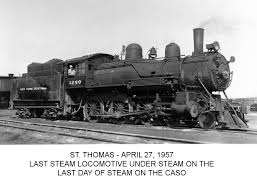May 2, 1957 Last steam locomotive operates on the New York Central as 2-8-2 Class H -7a 1977 drops its fires at Riverside Yard in Cincinnati. In the book, “Diesel Locomotives of the New York Central System” by W.D. Smith with H.L. Vail and C.M. Smith, on page #5, there is a photo. The engineer on the last run was A.N. Weidner who ended a 50 year railroad career on that day.
The New York Central System’s fleet of class H (2-8-2 type) locomotives was built in the 1910s and 1920s for main line freight service, but most were soon supplanted in that role by the Mohawks (4-8-2 type) and, on the Boston & Albany, the Berkshires (2-8-4 type). Nevertheless they soldiered on into the beginnings of the diesel era in local freight, branch line or yard transfer service. Indeed, a class H7 2-8-2 was the last steam locomotive to be operated by the New York Central.
Last steam on the “other end” Court Street, Kankakee to Hill Yard Indianapolis was Extra 2849 East on June 27, 1956.
June 30, 1956. Last run of Niagara 6015 in passenger service, train no. 416, Indianapolis to Cincinnati on account of a diesel failure. Departed Indianapolis 34 minutes late, arrived Cincinnati 6 minutes late. July 2, 1956. Returned to Indianapolis in freight service, train CC-3. Final run.
The seven A-2a’s built for the Pittsburgh and Lake Erie in 1948 was the last steam order for both Alco and the New York Central.
Nearly a century of steam locomotive history ended on September 25, 1952 when the last steam locomotive to be repaired there, J-1 “Hudson” No. 5270, left the New York Central’s West Albany Shops.
L3a “Mohawk”, 4-8-2, steam locomotive, #3001 built in 1940, it is the largest piece of NYC steam equipment left in existence.
The Centrals last steam run in New York state was on August 7, 1953 with locomotive No. 6020 taking train #185 out of Harmon. Employees Timetable, No. 71 from the Mohawk and Hudson Divisions dated Sunday, April 29, 1951 lists Train 185 as a MILK TRAIN with a footnote stating “Will not carry passengers”. Train 185 was a New York – Utica milk train that ran via Rensselaer Yard. It departed Croton at 10.50 a.m. My Electric Division and New York Terminal District Time Table shows No. 185 originating at 60th Street on the NYTD.
From roster books, there were 351 steam locos on the roster as of 1-1-1956. There were still 15 classes and 9 wheel arrangements. Quite likely most of these ran at least some revenue miles in 1955 which was the last year steam was used to any considearable extent. Within the first months of 1956 all of the fastest, newest and most powerful engines were retired. It was always easier to pay off new diesels by assigning them to the busiest traffic. All 49 remaining Js as well as 6 remaining niagaras and 7 P&LE 2-8-4s were retired in this period. By 1-1-57 122 engines remained mostly older types for local and switching service. This dropped to 27 by 1-1-58 and 25 by 1-1-59.
There is a big difference between engines shown as still being on the roster and supposedly serviceable but sitting in dead lines and engines under steam that were actually working whether in switching or pulling trains out on the road. Of the 122 engines remaining by 1-1-57 how many were actually in steam? I believe most if not all were stored serviceable either in roundhouses or sitting outside in case there was a sudden upturn in business and they ran short of diesels. If not, they could not use that particular locomotive.
On the Michigan Central’s Canada Southern or Canada Division as late as February 1957 2-8-0’s and 0-8-0’s in action. By the end of April 1957 they were all done.
***********
See more short stories https://penneyandkc.wordpress.com/a-collection-of-short-stories-about-railroads-book-one/
James Harringtons Creative Work





